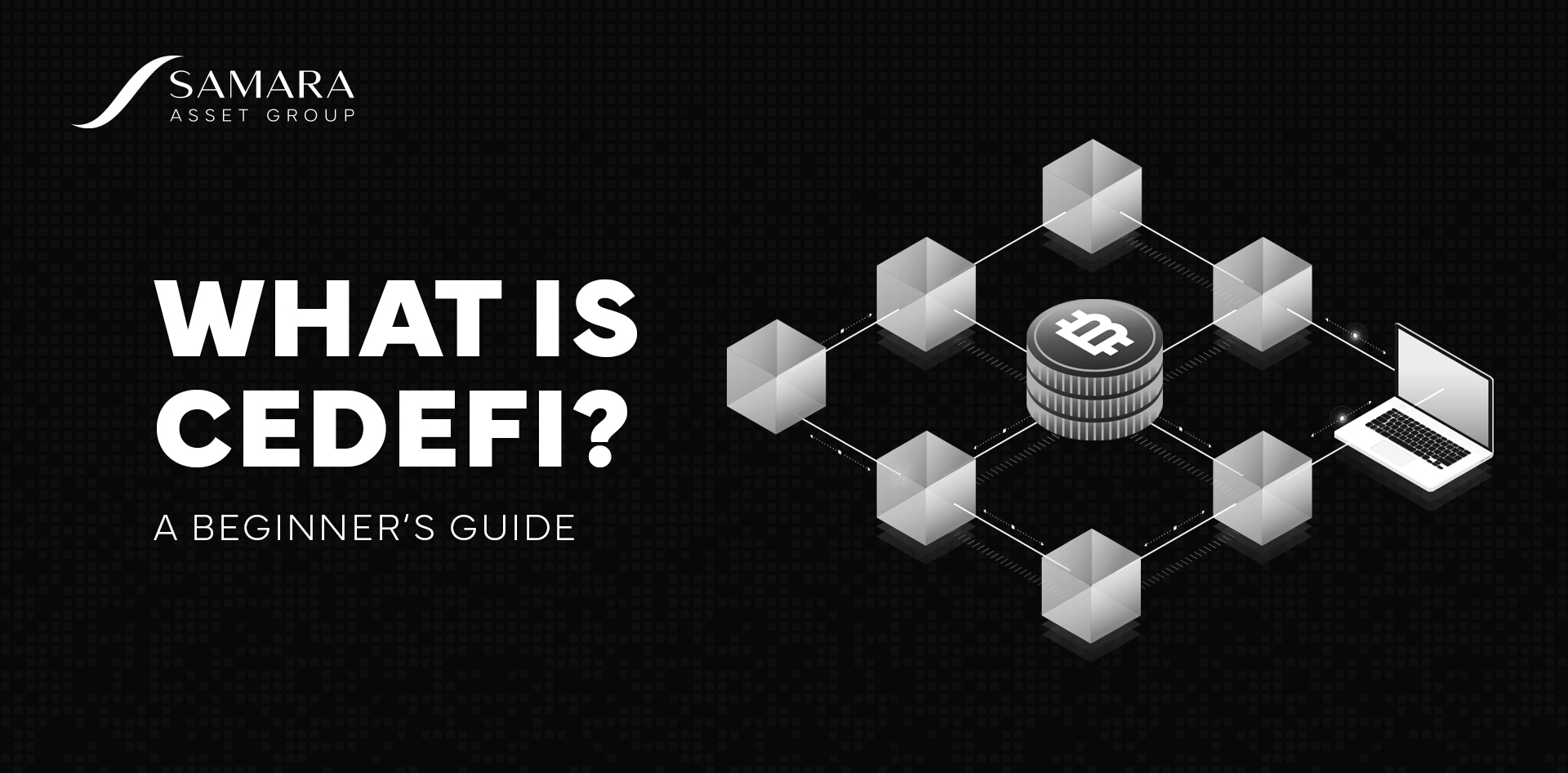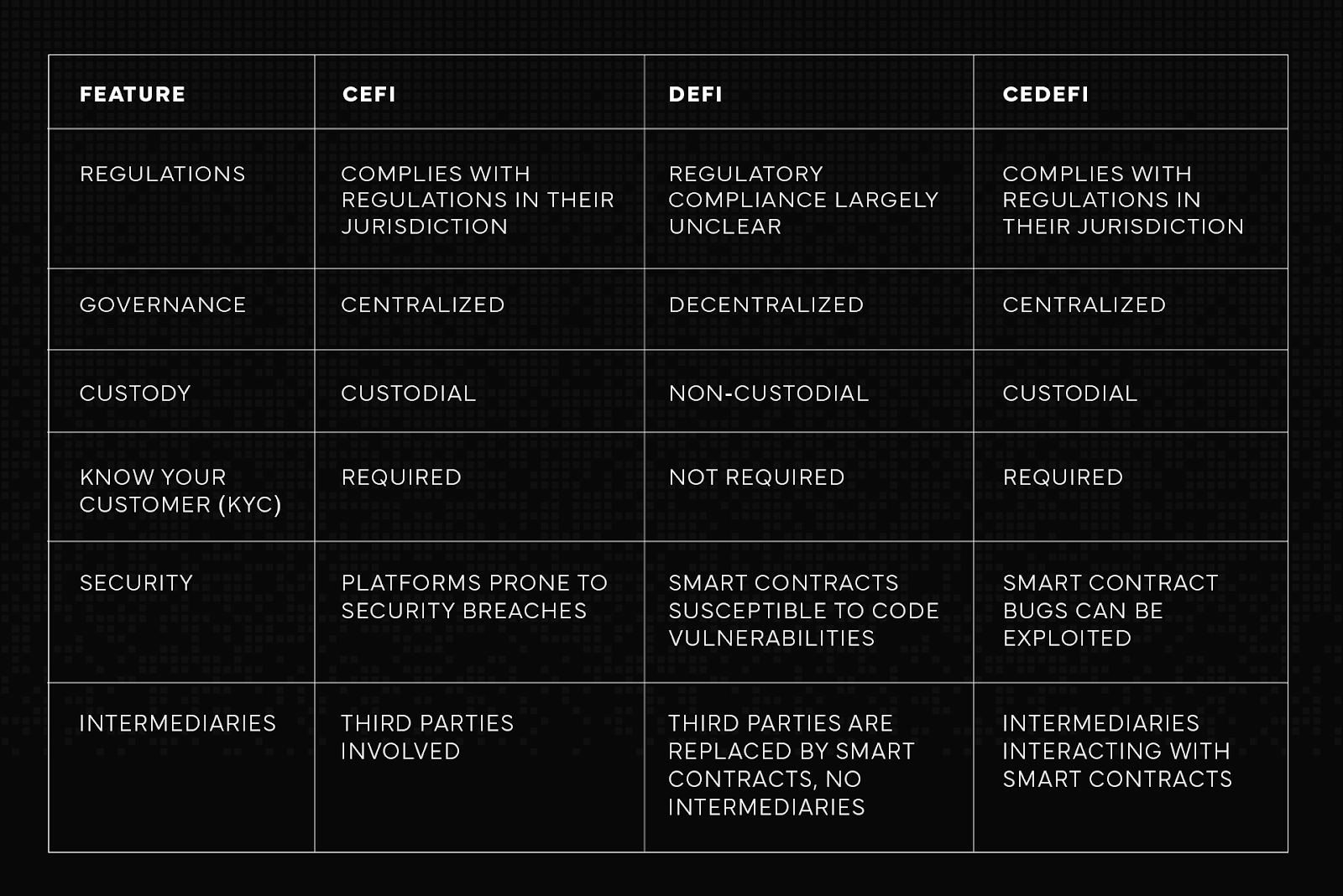Bitcoin
Bitcoin CPI
Venture Portfolio
Funds
Market Insights
Indicators
About
Contact

June 10, 2024





The crypto finance industry is split into decentralized finance (DeFi) and centralized finance (CeFi). While each model has its advantages, investors are still looking for a solution that matches their needs without compromise. CeDeFi has emerged as a potential middle ground that blends the best elements of CeFi and DeFi to improve efficiency in the digital asset ecosystem.
This guide will introduce you to CeDeFi, explain how it works, and discuss its benefits and risks.
Centralized Decentralized Finance (CeDeFi) is a hybrid financial system that combines the best attributes and features of CeFi and DeFi.
This blockchain innovation offers decentralized products like staking, yield farming, lending, and borrowing while leveraging compliance structures that govern centralized finance.
CeDeFi uses blockchain technology and smart contracts just like DeFi but within a regulated custodial CeFi framework.
This emerging space has the potential to match broader investor needs by providing a middle ground for digital asset investors who need to abide by traditional finance regulatory practices.
The CeDeFi ecosystem encompasses products and services that modernize traditional financial systems using blockchain technology.
CeFi refers to services with a structured financial system and regulations governed by a central authority.
While a central authority and regulatory framework are reassuring fallbacks for users, CeFi faces drawbacks such as lack of transparency and often higher fees. However, CeFi can vary widely in its transparency and fee structure based on the specific financial institutions and regulatory environments involved.
DeFi refers to peer-to-peer financial services that leverage blockchain to allow users to transact directly with each other using smart contracts, which eliminates the need for intermediaries.
While a decentralized system gives you more control over your assets and is more transparent, DeFi largely exists outside traditional regulations and may not guarantee the level of consumer protection that investors in traditional finance are used to. This notion is echoed throughout decentralized finance users as the rule of code.
Although DeFi operates with less regulatory oversight than CeFi, it's governed by the protocols encoded in smart contracts, providing a different kind of governance that is protocol-driven.

CeDeFi bridges the gap between CeFi and DeFi by addressing their respective shortcomings and harnessing their strengths to create a more efficient, accessible, and secure financial system.
The CeDeFi ecosystem draws custodial governance and decision-making from CeFi and complies with jurisdictional regulations similar to traditional systems. Additionally, CeDeFi channels DeFi by providing transaction transparency, fast onboarding processes, and on-chain security.
CeDeFi platforms offer services such as lending, borrowing, staking, and yield farming but under the governance of centralized custodians. One of the first platforms to explore CeDeFi was Binance, a centralized exchange that introduced its native blockchain: the BNB Smart Chain.
CeDeFi has a unique blend of features from DeFi and CeFi that lead to the following benefits:
However, CeDeFi is a concept that comes with some challenges, including:
CeDeFi provides a combination of attributes that can potentially appeal to both cryptocurrency enthusiasts and mainstream investors. Complying with regulations and vetting protocols in CeDeFi could bring more stability to the space and increase trust in the system, leading to wider adoption of blockchain.
However, the lack of intermediaries in DeFi is a big attraction for digital investors. Once DeFi protocols develop solutions to enhance the security and regulatory compliance of its platforms while remaining decentralized, CeDeFi may become obsolete.
CeDeFi stands for Centralized Decentralized Finance. It is a hybrid financial system that combines the best features of centralized finance (CeFi) and decentralized finance (DeFi), creating an accessible and secure ecosystem.
DeFi stands for Decentralized Finance, a permissionless financial system that leverages distributed ledger technology for peer-to-peer financial services eliminating third parties. On the other hand, Centralized Decentralized Finance (CeDeFi) is a unique blend of Centralized Finance (CeFi) and DeFi that offers DeFi services under a third party with regulated frameworks.
CeDeFi offers users the best attributes of CeFi and DeFi by using smart contracts to execute agreements within a regulated framework under a central authority. The financial model's benefits include faster transaction speeds, lower fees, improved security, verification processes, and accessibility.